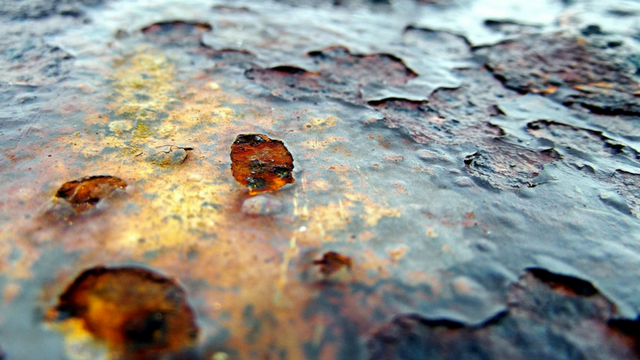Cathodic Protection Testing
Protection against corrosion increases the life of metallic fuel tanks and lines. Corrosion protection also avoids catastrophic results that could be caused by a release of product from the lines and tanks.
What Cathodic Protection Does
Cathodic protection is an electrical method to avoid corrosion. Cathodic protection uses the natural energy found in all metallic substances to protect underground tanks and lines from corroding. In simple terms, metal substances, known as anodes are buried in the ground next to the tank and lines. The anodes contain a high level of natural energy and are interconnected by a wire. The natural energy causes a flow of electricity through the soil, wire and buried metal. Over time the buried anodes completely dissolve into the soil which prevents corrosion from affecting the steel tank or lines. There are two types of cathodic protection systems: impressed current and sacrificial anode. Impressed current systems require an external power sources while sacrificial anode systems do not.
Three Tips for Maintaining Your Cathodic Protection System and Extending its Working Life
1. Are you having regular inspections?
Regular testing and inspection are recommended to make sure your system is working properly. Also, establishing a monitoring and log system can help with corrosion prevention efforts.
Inspections and a planned maintenance schedule can also make sure you are compliant with the latest Federal regulations. The regulations also deem that your system must be tested “by a qualified cathodic protection tester within six months of installation and at least every three years thereafter,” according to the Environmental Protection Agency.
But if you wait three years to test the system, the amount of damage that can occur to steel tanks and lines is enormous if your cathodic protection system hasn’t been working.
There are two reasons why you should test more frequently:
- A cathodic protection inspection is the only way to verify sacrificial anode systems are working properly. Sacrificial systems rely on a large number of buried anodes to prevent corrosion. These anodes are attached to the buried steel and over time lose their connection or have lower energy output. Because there are no meters to indicate that the system is working properly, an inspection is the only way to determine the anodes that need to be reconnected or replaced.
- Although impressed current systems have meters to indicate that electricity is passing through, the meter cannot determine whether sufficient power exists to prevent corrosion. A cathodic protection inspection is the only way to check whether energy output of every component is sufficient and to identify any parts that needed to be reconnected to the system.
2. Is your cathodic protection system providing the correct amount of protection against corrosion?
With impressed current protection systems, there is a rectifier control box that is usually located by the tank monitor. The rectifier box will always have a volt meter and may have an amp meter with a red/green indicator light. These meters and indicator lights only signal that power is on and do not determine whether it is sufficient. If the system’s indicator light is red, corrosion protection is offline. Contact a cathodic protection expert immediately.
Checking meter levels every 60 days and recording the readings in a log book is essential and required by state law. If the recorded readings fluctuate, the cathodic protection system may not be working properly. Cathodic protection professionals like ATS keep system records in an electronic format for owners so that the data is available for compliance purposes. This also makes it easy for the corrosion experts to identify problems immediately and quickly respond to get the system back in working order. Recording rectifier box readings every 60 days will avoid risking destruction of your tanks and lines and keeping a log will help reduce any unforeseen problems.
Sacrificial anode cathodic protection does not have any component that will indicate whether the system is functioning. This is why periodic cathodic protection inspections are extremely important. Although many states require a cathodic protection inspection every 3 years, annual testing should be adopted to help avoid extensive damage to buried tanks and lines.
3. Is wiring exposed on the system?
Check around the tanks for any broken or disconnected wires. There is a good chance these wires belong to the cathodic protection system. A broken wire could cause part of the system to malfunction and indicate the system is not providing protection against corrosion. It is a good idea to contact your cathodic protection professional to determine if these wires belong to the cathodic protection system. If the exposed wires are part of the cathodic protection system, necessary repairs will need to be made to make sure there are not any exposed wires. It should always be kept in mind that any digging in the area of the tank field could very easily disable the cathodic protection system. If you have any concerns you should contact your cathodic protection specialist.
Annual cathodic protection testing and keeping accurate cathodic protection records will save you money because it:
- extends the life of your cathodic protection system.
- keeps you in compliance with state regulations.
- prevents corrosion damage to buried tanks and lines.
Does your underground tank need a cathodic protection inspection?
Resources
New Jersey State and Federal Guidance Documents and links to Professional Trade Associations – available here.
Best Management Practices and Complying with NJDEP Regulations – see here.
window.addEventListener(‘LPLeadboxesReady’,function(){LPLeadboxes.setExitIntent(‘14406ef73f72a2:12def97c8946dc’,{dontShowFor:’0d’});});
Areas covered by this service
- New York (NY)
- New Jersey (NJ)
- Pennsylvania (PA)
- Connecticut (CT)
- Maryland (MD)
- Delaware (DE)
- Virginia (VA)





